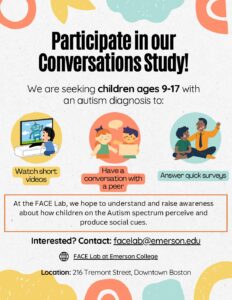How do autistic and non-autistic adolescents talk to each other?
What's the study about?
Your child will come to the lab to have several brief (five minutes) conversations with another teenager via Zoom. The teens will watch a two-minute video about related topics and then talk to each other about what they saw.
After the conversation, Both participants will also answer a few short questions about how much they enjoyed the interaction. Participants in the lab will wear eye-tracking glasses and all interactions will be video-recorded, so we can better understand each teenager’s gaze patterns and communication strategies during the conversations.
Who can participate?
Children diagnosed with autism, aged 9-17.
What will participants be doing?
- Participate in the informed consent process
- Watch four two minute videos about nature
- Discuss the videos with age-matched peers in 1:1 conversations via Zoom
- Complete several standardized questionnaires, including the ADOS, Social Communication Questionnaire, Clinical Evaluation of Language Fundamentals, and Kaufman Brief Intelligence Test.
- Complete basic vision and hearing screening
Time commitment: 4 hours in person plus 30 minutes virtual
Why is this important?
We hope to better understand how autistic and non-autistic teenagers communicate with each other. Specifically, we will analyze the language, facial expressions, and tone of voice of teenagers when they have a conversation with somebody and how those features change based on whether the two conversation partners share the same neurotype. We hope to also learn whether the satisfaction or enjoyment teenagers experience during these conversations relates to this neurotype matching or any specific verbal and non-verbal features. This study will help us better understand what conversational features are related to communicative success and enjoyment within and across autistic and non-autistic interactions.

